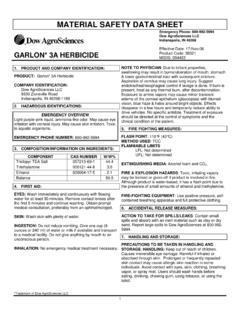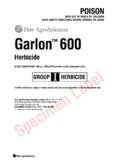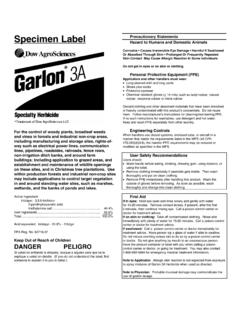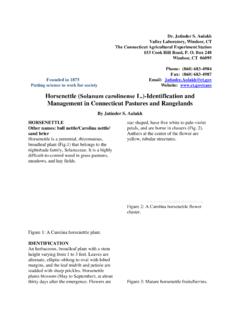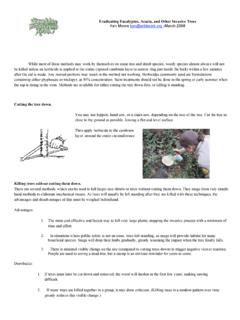Transcription of What you should know about Garlon 4 herbicide - …
1 Vegetation managers and foresters use Garlon 4 herbicide from Dow AgroSciences to control unwanted weeds, brush and trees beneath electrical power lines, along railroad beds, roadsides, pipelines, in commercial forestry and wildlife openings, including grazed areas on these sites. Garlon 4 contains the active ingredient following information provides specifi cs on Garlon 4 and explores questions often asked concerning its do you need to control vegetation along rights-of-way?For most right-of-way uses, safety remains a major reason for managing vegetation. Trees, brush and weeds along these rights-of-way can create driver and passenger safety, vegetation must not be allowed to block traffi c signs or roadside markers. It also must not conceal guardrails or overtake road shoulders. Vegetation must not obstruct driver vision at intersections or block the line of sight around curves.
2 Excessive vegetation also prevents proper drainage, which can damage roadbeds by creating potholes and other growing into power lines can cause electrical power outages and make maintenance diffi cult and dangerous. In addition, areas around utility substations and land beneath transmission towers require a vegetation-free zone to prevent fi re hazards and ensure the transfer of companies need to control weeds along their rights-of-way to maintain roadbeds. Weeds hold water around railroad ties. This causes the ties to rot, increasing chances for derailment accidents. Sparks from the rails can ignite weeds and brush growing too close to the roadbed, and can create a fi re hazard. Brush that obstructs motorists views at railroad crossings is especially dangerous. Controlling it can help avert car/train control vegetation to maximize the amount of timber they can harvest, resulting in more timber harvested on less land.
3 Controlling brush also decreases the potential for forest fi res and allows young stands to get plants, the ones that affect all of the areas we have talked about , threaten to create a monoculture where one plant type dominates an area. Invasive plants choke out native plant species and change wildlife habitats so animals cannot utilize the area. Selective herbicides control these invasive plant species while promoting native plants that in turn attract a wide range of wildlife. More than 50 years of research by Dr. William Bramble, a forest ecologist, and Dr. William Byrnes, an ecologist specializing in forest soils, support the use of selective herbicides to increase biodiversity. (The Bramble and Byrnes study was done in conjunction with Penn State University, Purdue University and the Pennsylvania Game Commission.)Why do you need to use Garlon 4? Can t you just cut the vegetation?
4 Mowing and trimming remain important parts of any right-of-way maintenance program. But mechanical means alone cannot protect a right-of-way adequately. Besides being very labor-intensive, mechanical methods can lead to soil erosion. In addition, fl ailing blades and moving parts pose a danger to employees, livestock and creates multiple resprouts the plant s natural defense to the cutting. This only worsens the vegetation some cases, mechanical methods quite simply cannot be used. Steep terrain may limit access by mowers, and in the case of railroads and substations, their crushed-stone construction makes mechanical weed control 4 controls unwanted brush and eliminates resprouting. Because of this improved control, crews and heavy machinery visit a right-of-way less frequently, thus, less impact on property near will be applying Garlon 4 herbicide ?A vegetation manager plans treatments with Garlon 4 herbicide and oversees crew activities.
5 Trained, professional applicators apply Garlon 4 in designated areas using approved application techniques. Organizations may use on-staff crews or hire custom applicators. In either case, these applicators follow directions on the product label, which is reviewed by the Environmental Protection Agency (EPA).Aerial applicators are highly trained and use specialized equipment to make you should know about Garlon 4 herbicideHow do I know these applicators are trained properly?Most states enforce strict standards requiring applicators to be state certifi ed. An experienced crew foreman oversees the application process to ensure all workers follow the specifi ed vegetation-control plan outlined by the vegetation manager. It s in the best interest of any organization to hire qualifi ed people to handle applications for the good of the organization itself and its standing in the will they apply Garlon 4?
6 Crews apply Garlon 4 to unwanted vegetation through a variety of application techniques. Options include foliar, basal bark and cut-stump treatments. Foliar applications spray solution on the plant s leaves. Basal bark techniques apply solution to the lower 15 inches of bark at the base of brush, while cut-stump applications spray or brush solution on the stump s surface after tree vegetation manager assesses plant variety and size, and environmental conditions at each site before determining the correct application rate and technique for that location. Other considerations include season, temperature, weather and do these applicators know they are applying the correct amount?The label indicates the rates to be used. Before an application begins, crews test and calibrate the application equipment to ensure they meet best management practices and any specifi c label Garlon 4 herbicide harm my ornamentals or garden?
7 Garlon 4 has the potential to harm any woody or broadleaf plant that comes in direct contact with the spray solution. Therefore, applicators take care to apply Garlon 4 only on targeted vegetation specifi ed by the vegetation manager. Garlon 4 will not harm grasses, like those in your lawn. Crews use extra caution to protect your ornamentals or garden by leaving untreated buffer zones that add an extra measure of protection. The basal application technique makes damage to ornamentals or gardens highly unlikely. Once crews apply Garlon 4 to the target vegetation s bark, it essentially locks into the plant. When making foliar applications, crews monitor wind speed and direction to assure control agents also can be mixed with the spray solutions to produce larger, heavier droplets that aid application accuracy and reduce the chance of off-target is the toxicology profile of Garlon 4 herbicide ?
8 Triclopyr, the active ingredient in Garlon 4, has been classifi ed as Category D not classifi able as to human carcinogenicity by the EPA. Toxicological studies show no evidence that triclopyr causes cancer, birth defects, genetic damage, genetic mutations, or adverse effects on the immune system or nervous system in pesticides sold in the United States must be accepted for registration by the EPA based on scientifi c studies showing that the pesticide will perform its intended function without unreasonable adverse effects on the environment. The EPA defi nes unreasonable adverse effects as any unreasonable risk to man or the environment, taking into account the economic, social and environmental costs and benefi ts of the use of the do you know the amount of Garlon 4 applied won t hurt animals?The active ingredient in Garlon 4 disrupts the growth process within a plant by affecting hormones unique to plants.
9 Garlon 4 does not have a similar effect on animals or ensure there are no unintended effects to pets, livestock or wildlife, the EPA requires more than 120 different tests. Researchers determine the highest dose of a product that still shows no negative effect on animals, and call this the No-Observable-Adverse-Effect Level (NOAEL).Scientists also determine a maximum exposure level exposure to the highest estimated concentration level that could be expected with normal use. Using these two measurements, they calculate a safety factor for effects on animals. This factor shows a multiple 1 Another formulation, Garlon 3A herbicide , is labeled for control of emerged weeds and brush in standing water or on banks and shores of ponds or lakes found on rights-of-way or production the maximum exposure level that an animal would have to be exposed to in order to reach instance, a factor of 10X means that an animal would have to be exposed to 10 times the maximum expected labeled application rate of Garlon 4 herbicide to reach you can see in the Exposure Assessment chart, there s a large margin of safety for birds.
10 However, you ll fi nd no additional margin of safety fi gures of aquatic organisms. This refl ects laboratory studies that show Garlon 4 applied directly to water and artifi cially maintained for 96 hours at a concentration equal to 2 quarts per acre, in a 1-foot deep stream or pond, is potentially harmful to aquatic conducting fi eld trials in a natural aquatic setting fi nd it s impossible to maintain that laboratory concentration for 96 hours due primarily to degradation. These study results for Garlon 4 show that the moderately toxic ester formulation quickly converts to the practically nontoxic technical acid within a few hours. In other words, intentional applications to water in outdoor fi eld trials did not reach toxic levels for the length of time necessary to cause these aquatic studies indicate some margin of safety, applicators do not apply Garlon 4 to In addition, they leave buffer zones (land where no herbicide is applied) between the application site and lake, river or stream to add an extra measure of addition to the safety factor, you ll also fi nd a relative toxicity designation.
